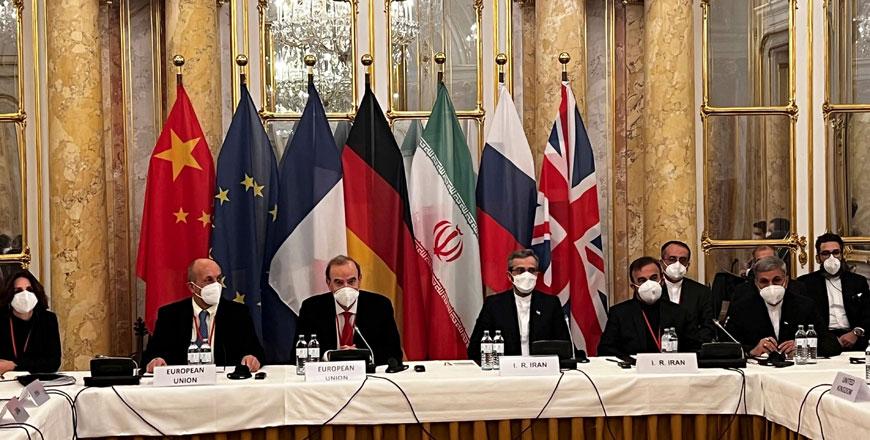You are here
Iran’s nuclear saga: From 2015 accord to new talks
By AFP - Aug 08,2022 - Last updated at Aug 08,2022

In this file handout photo taken and released on December 3, 2021 by the EU delegation in Vienna shows representatives from Iran (right) and the European Union attending a meeting of the joint commission on negotiations aimed at reviving the Iran nuclear deal in Vienna, Austria (AFP photo)
PARIS — The main developments in Iran’s nuclear programme since 2015, as Tehran examines a “final text” in Vienna aimed at restoring a landmark deal with world powers.
Historic accord
In 2013, newly elected Iranian president Hassan Rouhani says he is ready for “serious” negotiations on Iran’s nuclear programme, following an eight-year stalemate under ultraconservative Mahmoud Ahmadinejad.
Rouhani secures support from supreme leader Ayatollah Ali Khamenei for efforts to break the deadlock.
On July 14, 2015, Iran and the five permanent members of the UN Security Council — Britain, China, France, Russia and the United States — plus Germany reach a historic accord in Vienna.
The deal places significant restrictions on Iran’s nuclear programme in exchange for sanctions relief after 12 years of crisis and 21 months of protracted negotiations. It comes into force on January 16, 2016.
Under the accord, Tehran’s nuclear programme is placed under strict UN control subject to guarantees it is not trying to make an atom bomb, something Iran has always denied.
Trump pulls out
US president Donald Trump walks away from the deal on May 8, 2018.
“We cannot prevent an Iranian nuclear bomb under the decaying and rotten structure of the current agreement,” he says.
Deal critics had complained from the start about the time limits applied to the deal.
Later in 2018, Washington begins reimposing sanctions on Iran and companies with ties to it, hitting the central bank and the country’s vital oil sector.
Major international firms halt activities in the country.
Iran walks back
In May 2019, Iran starts rolling back on its deal commitments in retaliation.
Trump hits back by sanctioning Iran’s steel and mining sectors.
Tehran increases its stockpile of enriched uranium in excess of the limits laid down in the deal.
It announces in early 2020 it is foregoing a limit on its number of uranium-enriching centrifuges.
In 2021, Iran says it has started enriching uranium to up to 60 per cent — many times the limit of 3.67 per cent imposed by the deal — which the International Atomic Energy Agency (IAEA) says could be sufficient to create a compact nuclear explosive.
Vienna talks
In April 2021, with President Joe Biden now in the White House, talks on rescuing the accord start in Vienna.
Iran’s new ultraconservative president, Ebrahim Raisi, says in August he is open to negotiations but will not be pressured by sanctions.
Talks resume in November.
Compromise ‘close’
Just as a deal looks imminent, Russia invades Ukraine on February 24, 2022 and Moscow becomes the target of international sanctions. The negotiations are delayed.
In mid-March, Washington says a compromise is “close”, but Tehran raises some “red line” issues, including its bid to have all sanctions lifted.
New US sanctions
On March 30, Washington sanctions suppliers to Tehran’s ballistic missiles programme, which Iran dubs “another sign of the US government’s malice” towards the Islamic republic.
Nuclear watchdog
raps Iran
On June 8, the IAEA adopts a resolution submitted by Britain, France, Germany and the United States that condemns Iran for the first time in two years.
Iran responds by removing surveillance cameras at nuclear facilities.
On June 16, Washington sanctions a network of Iranian petrochemical firms.
‘No progress’ at Qatar talks
In late June, two days of EU-brokered indirect talks in Doha between Iran and the United States conclude with no progress.
Return to Vienna
On July 26, EU foreign policy chief Josep Borrell says he has submitted a draft text of a deal, urging parties to accept it or “risk a dangerous nuclear crisis”.
On August 4, negotiators gather for a fresh round of talks.
On August 7, Iran demands that the UN nuclear watchdog “completely” resolve outstanding issues related to questions over nuclear material at undeclared sites.
On August 8, Iran says it is examining a “final text” presented by the European Union.
Related Articles
Iran and world powers started drafting Wednesday a comprehensive nuclear agreement but still face many sticking points, Iranian Foreign Minister Mohammad Javad Zarif said.
Iran’s supreme leader Ayatollah Ali Khamenei on Wednesday instructed his country’s negotiators to steer clear of “humiliation” in nuclear talks with world powers that resume next week in Vienna.
VIENNA — Iran's nuclear negotiator Abbas Araqchi said on Monday he expected a deal with six world powers on shrinking Tehran's atomic progra
















